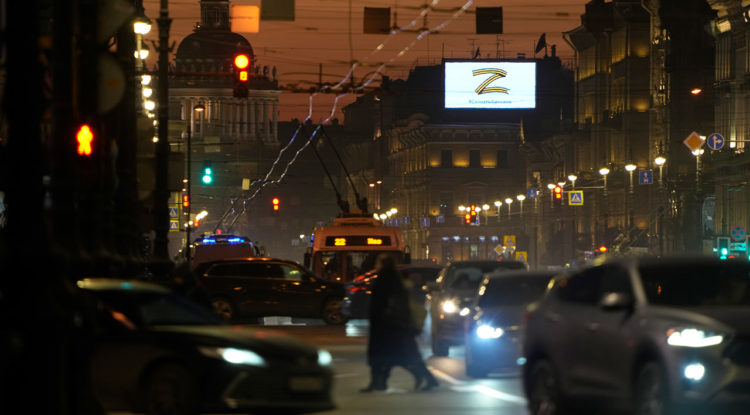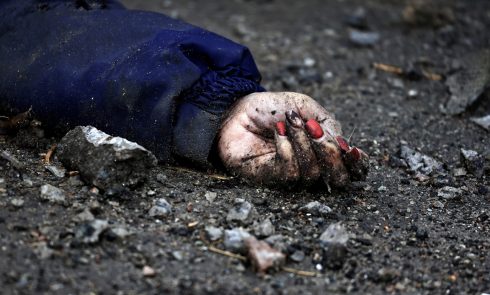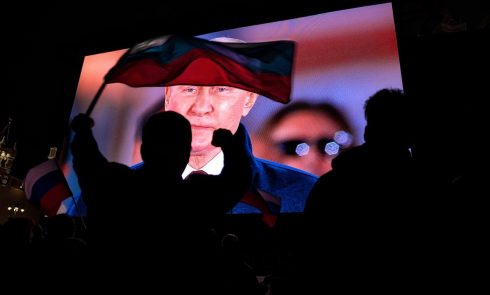For many years, Yulia Galkina has been writing about the history of St. Petersburg's houses and entrances, city planning, and city problems. In her texts, her criticism of authorities is combined with her love of the urban space. Stories of Petersburg Houses Told by Their Residents, a book co-written by Galkina, Anton Akimov, and Maksim Kosmin, became a bestseller on local history and has been republished several times. However, Galkina admits that she has not been able to write texts about local history since the war began. Though the streets and houses of St. Petersburg do not attack anyone, she feels less and less tenderness for them now. She explains how it happened.

One day, a year before the war started, I was walking along Neftyanaya Doroga road in St. Petersburg when I saw a tank outside the building No. 5, where an enterprise manufacturing body armor, tasers, and handcuffs is situated. Near the tank monument there were two people: a man and a boy stroking the tracks and smiling. “This glorification of militarism is just horrible, folks,” was what I wrote in my local history blog after I saw them.
An outraged follower commented that pacifism sucks and that I should know that there are people whose duty is to defend the likes of me, who, however, should rather be executed.
On May 9, 2022, another man and another boy were walking behind me, a journalist on an editorial assignment, down Nevsky Prospect, in the procession of the “Immortal Regiment” (a huge patriotic event where people walk the streets holding portraits of WWII veterans—ed.Holod), probably the last one, as in 2023 the event was canceled. I overheard the man's monologue:
“Every person must have a meaning. My meaning is to serve my country. I served in the army for twenty years, and now I work at a military factory, with which we defend our motherland. And if you are a small man who spends his whole lifetime staring at one of these gadgets, what use are you to your homeland and your society? What the fuck were you born for?”
My heart raced and I felt rumble in my ears. I had already seen them “defending their homeland”—on the news—in Mariupol and Bucha, in Odesa and Kyiv. I felt sick and scared.
Militarization of life and, as a consequence, of the urban spaces, both public and private, did not happen suddenly, but over the 2010s and beyond: from the wooden tank on the Chekistov street (appropriately named after the Soviet secret police) to the “Island of Forts” park in Kronstadt, a project of the defense minister’s daughter, in which militarism is celebrated using fashionable tools of urban design.
Not for long I would find this to be entertaining, as a devotee of the punk approach to local history. The ridiculous militaristic art created by the residents themselves was a glitch in the conservative fabric of the city, and the new official military monuments felt grimly serious, but not dangerous. Then I realized that both this low-level stupidity and this officialism of the state were far from harmless. As the tanks and uniforms became habitual, they normalized militarism.
Last March, the semiotic set of a St. George's ribbon and a tank was joined by the letter Z, which has been all over the city as well as regional spaces. The climax was a large Z letter on the Blockade Breach Museum near Kirovsk, next to the portraits of the siege of Leningrad survivors and their quotes about the everyday life, the horror and death during the war. One of them said: “"In December and January a lot of people started dying. And there were corpses lying in the streets. There was no one to bury them—we could hardly even walk” (Irina Timofeyevna Kolyadina, 89 years old). What arguments more terrible against any wars do we need, other than the Siege of Leningrad or Babi Yar in Kiev?
This forced fusion of glory and grief is an illustration of using two techniques at once: glorification and memorialization. In conversations about any war or repression, I choose the second method: not the attractions of the ‘sland of Forts’, but the cenotaphs of the Levashovo Memorial Cemetery, the Chekists' execution ground, which was discovered in 1989 by the Memorial Foundation. And the government is choosing the first: it bans the Memorial Foundation and aggressively spams the city streets with the portraits of the “heroes” of the invasion of Ukraine. They don't preserve memory, but criminalize it, like any manifestation of a living mind and heart. The past can only be heroic. And then, instead of the memory, there are myths, which the authorities make sacred (for example, by legally recognizing the Siege of Leningrad as genocide).
The symbols become more important than the things they symbolize, and if one vandalizes a template monument to, for example, Marshal Zhukov, they are punished more severely than if one keeps silent about the unheroic pages of the siege.
When leaving Russia, I took three paper books, one of them about the siege of Leningrad. There, on page 360, I came across a quote of artist Lyubov Shaporina describing her experience during the blockade. She was working in a hospital as a nurse, and after 1944 she collected documents about the theater and music during the blockade. On July 5, 1942, she wrote: “We are all to blame for the current state of affairs. <...> Do you remember the starving Ukrainians lying all over the place at Vitebsk railway station ? <...> And we would pass them by, well-fed, after the parties, wearing nice coats, and it seemed to us that it was all somewhere far away. It didn't bother us. Now the whole country is paying the price.”
It turns out that a St. Petersburg researcher can voice either myths or the not-yet-forbidden facts about the past of the city, but should keep the other facts to themselves. Otherwise they might face denunciations, fines, or even jail time. How does one write and speak about the city in an unfree country?
How does one keep silent about the similarities? For example, a refugee from Mariupol shows me a picture of what's left of his house. The façade is black, and on the inside, there are fragments of furniture and pieces of concrete. The ceilings between the floors collapsed in the middle of the room—and absurdly, like an uncounted decoration, a couch stands above the opening, intact. It reminds me of the other pictures, from the besieged Leningrad. Like Lydia Ginzburg wrote: “There were cutaways of small multicolored rooms with an intact round stove, which had been painted to match the wall color, and a door, sometimes slightly open.”
In the early months of the Russian invasion of Ukraine what bothered me more than the “how” to speak about the city would be the “what for?” It was a native of St. Petersburg that sanctioned the destruction of other cities, together with the people living there. As I am writing this, it is reported that a Russian missile struck a local history museum in Kupyansk, a town in the Kharkiv region. Two female employees were killed. It's impossible not to think about this while admiring the facades of St. Petersburg houses—unless, in the words of singer Yury Shevchuk, one “quickly covers the familiar deaths and bones with a soft little world,” meaning, unless you choose not to notice anything. It is also not possible to stop thinking about the architects from St. Petersburg (some of whose facades are also worthy of admiration) right now designing the new houses, this time in the occupied Mariupol.
My entire career, as well as my life, has been connected to researching my favorite city, St. Petersburg. After February 24, 2022, this “soft little world” was torn from my bones. In a way, I feel alone. My friends say, “It's not Petersburg's fault. It will survive anything. I won't give them my Petersburg.” I envy their ability to love it so much. As for me, I grieve more not for the city itself, but rather for the ability to love it as much as I did before.
The opinion expressed in this publication is that of the author and does not necessarily reflect Holod’s opinion.


